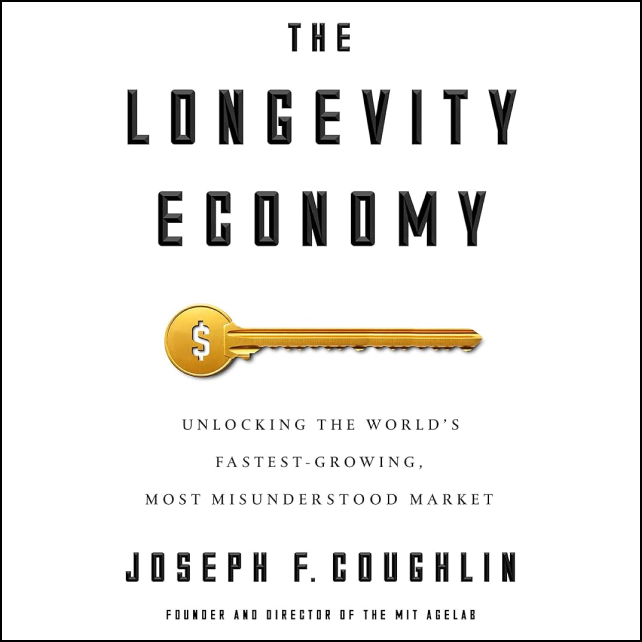MY PASSION PROJECT
Creating better options for aging...well
I’m investing time in building community, sparking conversation, and supporting founders, audiences and advocates in the AgeTech ecosystem so we’ll all have a wealth of great options for living better as we age.

“AgeTech is where longevity meets technology to help us age better. It is inclusive of all tech - HealthTech, FinTech, Smart Home, Mobility, Transportation, FemTech, Social Connection, Lifestyle, etc - and it’s not just for older people.”
WHAT IS AGE TECH?
Andy Miller
SVP, Innovation & Product Development @ AARP
Why AgeTech?
For me, it’s part personal, and part practical.
On the personal front, I credit my mother-in-law with kick-starting my interest. Maturing as a female leader in tech has played a defining role too. I’m definitely one of those “Do not go gentle into that good night” sort of people. I crave agency. I want the later decades of my life to be ones in which I choose how my life and career unfolds. I’m also the sort of person who, when faced with a problem or challenge, immediately starts looking for (or creating) solutions. In typical product development fashion, I started off with discovery, and wow, is this an interesting, challenging and exciting space.
On the practical front, the world’s population is aging, rapidly. By 2034, there will be more people over 65 than under 18 in the US according to the US Census Bureau. That will be a historic first.
This group of older adults has significant spending power and economic influence. In 2024, older adults (people aged 50+) are expected to account for 42% of total spending worldwide according to the AARP’s Global Longevity Economy Outlook report. In 2020 the 50-plus population contributed $45 trillion to global GDP (34% of the total). That’s about three times the combined revenue of the world’s 100 highest earning companies in 2020. Rapid population aging around the world ensures this will only increase over time, yet current public policies, cultural norms, and business practices frequently fall short of maximizing our ability to innovate and spur economic growth that benefits all generations.
At the same time, we’re facing an epidemic of loneliness and social isolation according to US Surgeon General reports, which causes significant health risks and dramatically increases the likelihood of premature death. It costs the US economy an estimated $406 billion annually and Medicare costs for socially isolated older adults account for $6.7 billion a year alone.
Living longer means most of us will have to work longer to maintain our quality of life, and many of us will want to keep working, to feel relevant and stay engaged. According to the US Senate’s Special Committee on Aging, the number of Americans over age 55 in the labor force is projected to increase from 35.7 million in 2016 to 42.1 million in 2026. By 2026, aging workers will make up nearly one quarter of the labor force. However, age discrimination, inadequate training opportunities, working while managing health conditions and disabilities, balancing caregiving responsibilities with work, and preparing financially for retirement are real and present challenges for our aging workforce.
On the caregiving front, the US’ caregiver shortage is projected to lead to a $290 billion per year loss to U.S. GDP in 2030 and beyond, because of the lack of available workers to fill caregiver roles and the departure of productive employees from the paid labor force to take on unpaid care duties, whether they want to or not. More than half the U.S. workforce (~90 million people) has caregiving responsibilities for children, a spouse, or older family members, and on average those responsibilities amount to 30 hours of unpaid work every week.
Taken together, this creates a huge opportunity to develop solutions that will not just support people as they age, but enable us all to age well, stay well longer, maintain agency, and have better options available across the spectrum of healthcare, mobility, employment, caregiving, housing, transportation, and social connections.
I take responsibility for being an agent of positive change. What that means right now, is investing time in building community, supporting innovative contributors, sparking conversation, learning from others, and fostering creative solutions in AgeTech and the Longevity economy so we’ll all have great options to support living well as we age.
Get Involved
-
Agetech and the Longevity Economy LinkedIn Group
I created this group in June 2023 after organizing my first local AgeTech meet-up as a way to connect people interested in the space, share innovative work, and highlight key contributors. It’s been growing ever since. and is now the largest public group of its kind on LinkedIn.
-
AgeTech Boston
Along with my colleagues Danielle Duplin and Jenny Xie, we head up the Boston chapter of AgeTech Connect, a nation-wide (+ Canadian) group brining the AgeTech community together - across founders, funders, researchers, policy makers, academics, experts and older adults to foster innovation, collaboration and spur change that moves the needle.
-
AgeTech Investor Network
The AgeTech Investor Network connects forward-thinking investors with industry-leading startups poised to lead the transformation in AgeTech solutions. I’m a member and Angel investor, and have found it to be a great way to keep up with interesting companies entering the market and new developments in the space.
-
Boston Bridge
A non-profit, affiliated with the AgeLab at MIT focused on professional development and mentorship for emerging and established leaders in the field of aging. I’m a member and attend most monthly meetings.
-
AgeLab @ MIT
Check out opportunities to get involved through MIT’s AgeLab. My mother-in-law is on their Lifestyle Leaders Panel. The work they kicked off in Spring 2024to develop a first-of-its-kind longevity preparedness index is especially exciting.
-
AARP’s AgeTech Collaborative
Early adopters, start-ups, pitch events, an incubator program and events that bring together founders, funders and thought leaders in the space.
Learn More
A fantastic online resource curated by Keren Etkin that includes a market map of the AgeTech space. Don’t miss it.
The Genontechologist
As the demographics of global aging transform and accelerate, it is now critical to build a new understanding of the shifting physiological, cognitive, social, family, and psychological realities of the longevity economy...because oldness is a social construct at odds with reality that constrains how we live after middle age—and stifles business thinking on how to best serve a group of consumers, workers, and innovators that is growing larger and wealthier with every passing day.
The Longevity Economy by Joe Coughlin
In the United States, one in five Americans will be 65 or older by 2030. This shift will affect every aspect of business operations, but corporate leaders don't seem to grasp the many ways an aging workforce will change the rules of the game. Those who do realize this see a crisis, not an opportunity.
HBR Big Idea Series: The Aging Workforce
Boston Globe special series: The Longevity Hub
A comprehensive series that seeks to spark Greater Boston's transformation into the Silicon Valley of aging.
Model Village
A perfect encapsulation of what a great solution looks like.

-
Reach out and Say Hello!







